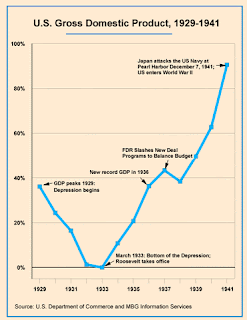Perhaps the whole difference is here (large size here):
Nonetheless...the curve of economic freefall staunched and a raft of social welfare legislation passed while the President tacked back and forth between bold action and pulls back on the reins does lend an outline of faint resemblance to the two first terms. The history rhymes a bit -- and Michael Hiltzik, who just published his The New Deal: A Modern History this September, has got to be conscious of that. Hence the occasional eye-rubbing passage such as this, surveying FDR's political standing in January 1936:
Criticism of the New Deal had been building on the left and the right. Both camps were unhappy with the political accommodations Roosevelt had made over the previous three years. The Left was discontented by his failure to impose dramatic change on the structure of finance and industry. On the Right, the New Deal's regulatory schemes, its proliferation of executive agencies with broad yet ambiguous new powers, and its hostile rhetoric about "money-changers" and wealthy malefactors reinforced suspicions about Franklin Roosevelt dating back to the 1932 campaign. The listless pace of recovery fueled misgivings among the public. The man on the street had yet to see the return of a robust job market, farm prices were still depressed, and economic activity was still heavily dependent on relief programs, the latest of which was the $4.9 billion WPA, launched in 1935.As for Roosevelt's subsequent denunciations of malefactors of great wealth, remembered with such dewy-eyed warmth today by the likes of Drew Westen: as noted in a prior post, they were motivated chiefly by FDR's need to cover his left flank against a third party challenge.
Big business saw the Roosevelt administration as an unreliable and uncooperative partner in efforts to get the country moving again. True, the New Deal had granted some of industry's most cherished wishes by suspending the antitrust laws via the NRA and instituting an inflationary monetary policy; but what it gave with one hand it took away with the other--new banking laws, securities regulation, a strengthen Federal Trade Commission, and a general reluctance to accept business leaders into White House councils (Loc. 6531).
FDR was far more comfortable and confident imposing his will on a Democratic Congress than Obama was in 2009-10. He was more sure-handed politically, and he found new means to bond with a far less jaded -- if more intensely suffering -- electorate (it was easier then: FDR averaged about 3 fireside chats per year). And he ran up against the limitations of power at the beginning of his second term rather than in the middle of his first. Still, the distant mirror occasionally throws off some startlingly familiar silhouettes.

No comments:
Post a Comment